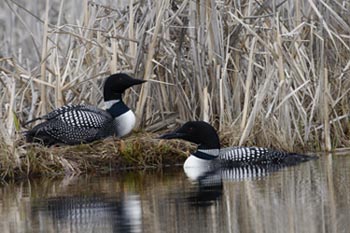The great northern diver: The Common Loon—winter 2010
Filling the evening air of early summer with its haunting wail and yodel-like call, the Common Loon has long been an inspiration for stories and legends. The Chippewa believed the cry of the loon was a harbinger of death. Tsimshian mythology describes how Common Loons received their distinctive necklace in return for restoring the sight of a tribal leader.
Dressed up in their breeding best—a dark bill, head and neck setting off a white-striped necklace and matching boldly checked mantle—Common Loons nest along the shoreline of large secluded lakes throughout northern North America and Europe. They lay just two eggs, and both parents vigorously guard the nest and can be seen taking their chicks for a ride. Sensitive to shoreline development and boat disturbance, and dependent on lakes large enough to provide plentiful fish and lots of room for takeoff and landing, their breeding range has been restricted northward into Canada as development from Maine to Washington has increased. Alaska’s breeding population, however, is large, at 9–13 thousand birds.

Two common loons dressed up in their breeding best (G. Gumm)
Powerful birds built for pursuing small fish, loons have dense bones that act to decrease buoyancy and help them dive to more than 60 meters. With extremely large webbed feet and tarsi as broad and flat as tongue depressors, smelt, herring and sandlance are no match for these fearsome predators. But, what makes them lithe, beautiful swimmers turns loons into cumbersome, awkward creatures on land—with legs located far back on their bodies, loons are unable to walk or even stand. Once airborne, these birds can fly—just under 100 kilometers an hour is their average speed.
Winter finds these birds in the nearshore marine environment of the east, west and gulf coasts, sporting drabber non-breeding plumage—pale gray bill, dark head fading into a pale chin and throat, and few to no spots on the mantle. COASSTers regularly find them all along the coast, from late August to early April. Depending on the year, 5–30, mostly non-breeders, have washed up. During the harmful algal bloom wreck of marine birds along the outer Washington coast (see page 14), more than 30 loons washed in, mostly Red-throated. Oil spills can also have negative impacts—just over 70 loons were recovered along the Washington coast following the December 1988 Nestucca oil spill.
In the lower 48, Common Loon populations are small—Washington State has less than 20 known breeding locations, and the species is listed as Sensitive. In addition to development and disturbance, conservation issues include sensitivity to pesticides and heavy metals—most especially lead from recreational fishing sinkers and bio-accumulated mercury from airborne power plant emissions. In an effort to curb the declining numbers of Common Loons, conservation efforts involving scientists and citizens are underway throughout North America. Many wildlife agencies have advocated for the use of non-toxic fishing gear, as well as reducing boat and jet-ski disturbance during the breeding season. Citizens have plenty of opportunities to be involved. More than 60 volunteers contribute their sightings of breeding Common and Pacific Loons to the Alaska Loon and Grebe Watch program annually. And—of course—COASSTers from California to Alaska help to monitor the wintering distribution of this highly recognizable bird.
Check out these websites for more information about Pelagic Cormorants: